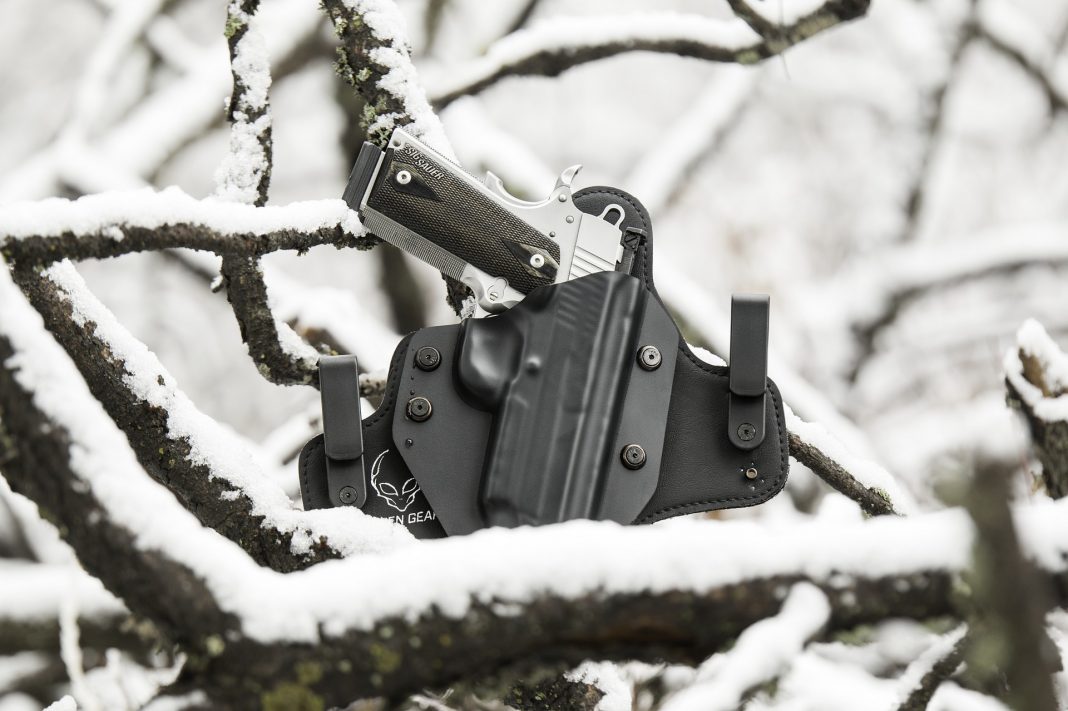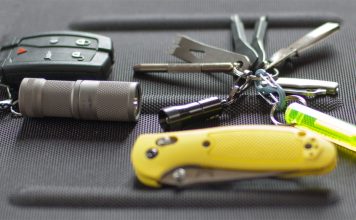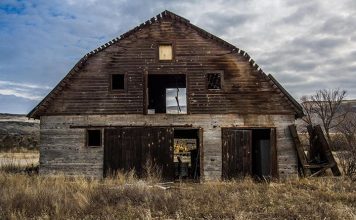 |
|
| Issue #83 • September/October, 2003 |
If you’ve read American firearms history at all, you know the lore of the .45 automatic. How during the Philippine insurrection, the newly issued .38 revolver failed miserably against psyched-up Moro warriors, and ancient .45 revolvers were dragged out of mothballs and re-issued to embattled American troops in the Pacific. How this led to the Thompson/LaGarde study of handgun ammunition effectiveness in 1907 that indicated nothing of less than .45 caliber should be issued as a sidearm to US troops. And how John Browning’s brilliant design of a semiautomatic pistol in that caliber, as manufactured by Colt, was subsequently adopted as “Pistol, US, calibre .45, Model of 1911.”
|
In the trenches of WWI, for the first and the last time in American military history, it was determined that every single one of America’s troops needed to carry a .45 caliber handgun at the front. Though the “.45 automatic” was the first choice, the industry couldn’t make enough of them and both Colt and Smith & Wesson pressed their revolver lines into production for the classic Model 1917 double action revolvers. These used ingenious half-moon clips developed by S&W to hold three of the “rimless” .45 auto cartridges together for fast reloading of these “revolvers using autoloader ammo.” Not until the last quarter of the 20th century would shooters figure out that a full moon clip could hold six such cartridges at once. This allowed the fastest possible revolver reload…right about the time all the cops decided they wanted semiautomatic pistols, which were faster still to reload.
Time marched on. In the early 1920s, a US military board convened to determine what had been learned in the Great War that could improve the design of the nation’s military small arms. It was determined that about half the soldiers thought the 1911 pistol had too long a trigger, too short a grip tang safety, and sights that were just about useless. Before 1930, this advice coalesced into the improved Model 1911A1. Its trigger was much shorter and easier to reach, and this was aided by new scalloping around the trigger guard area of the frame. Bigger sights that were easier to see were added. The hammer was reconfigured and the grip safety’s tang lengthened in hopes of preventing the pinch at the web of the hand that many doughboys had reported when the gun was cycling. The 1911A1 would remain the classic shape of this classic pistol for the remainder of the century.
“Legendary Manstopper”
The bolt-action 1903 Springfield and 1917 Enfield .30/06 battle rifles had proven themselves splendidly rugged and accurate when sniping at enemy soldiers across the battlefield. But, when the enemy was right there in the trenches with you, ready to spear you with the blood-stained bayonet of his Mauser, these long, heavy rifles that needed a four-step process to hand-cycle another cartridge into the firing chamber were not the optimum defensive tools. The 1911 pistol, on the other hand, proved to be in its element there. Eight quick flicks of the index finger unleashed eight heavy 230-grain bullets, almost half an inch in diameter and traveling some 830 feet per second. At close range, when a single .45 slug struck the enemy in the wishbone, he tended to be immediately rendered hors de combat. To hell with bayoneted rifles, said the doughboys; this Colt .45 automatic was the ticket to getting out of the trenches alive once the enemy hordes had flowed into those trenches with you.
|
Countless tales of up close and personal pistol fighting emerged from WWI. The bottom line was that when Americans shot Germans with Colt .45 automatics, the Germans tended to fall down and die. When Germans shot Americans with their 9mm Luger pistols, the Americans tended to become indignant and kill the German who shot them, and then walk to an aid station to either die a lingering death or recover completely. Thus was born the reputation of the .45 automatic as a “legendary manstopper,” and the long-standing American conviction that the 9mm automatic was an impotent wimp thing that would make your wife a widow if you trusted your life to it.
Then came WWII. The .45 automatic was the standard military weapon then as well. Used heavily in both theaters of the war, it was particularly valued in the Pacific, where Japanese sappers tended to infiltrate through the wires and be on top of the Yank soldier with knife in hand when the American woke up to deal with it. And the legend of the .45 as the “one shot, one kill” weapon was reinforced. It did not hurt that reputation that the average target in the Pacific was a rice-fed, half-starved biped who weighed about 130 pounds.
Then came Korea, and then Vietnam. Nothing happened to change the image of the .45 automatic as a deadly manstopper. In the mid-1980s, several trends converged upon the one firearm that had served the American military the longest. NATO was pushing the USA for complete compatibility in small arms ammo, and every other nation carried 9mm pistols. Except for target pistols for the pistol teams, the US government had not purchased new 1911s since before the Korean War, and the old guns were getting pretty clapped out. Finally, it is said, the Pentagon wanted cruise missiles in Italy and Italy wanted a lucrative US military contract in return. In any case, it was at that time that the United States armed services adopted the Italian Beretta Model 92F, caliber 9mm, as the official US service handgun that would be designated the M9 and would replace the 1911.
Fast forward to the present. When the War Against Terrorism went into the caves of Afghanistan, pistols became the weapons of choice for soldiers working on point in very close quarters. It became apparent that the 9mm with full metal jacket Geneva Convention ammo was as impotent as it was in WWI, with Al-Queda fanatics soaking up several rounds before they gave up the ghost. Those Yanks fortunate enough to have .45sArmy Delta Force, who purchase their own 1911s out of a stipend provided, and all the Special Operations Command elite who have access to the HK SOCOM pistol in that caliberfound that one or two full metal jacket .45 hardball rounds were all it took to drop a terrorist in his tracks. The call went out again: “We need .45s.”
|
What goes around comes around. Santayana was right. Those who ignore history are doomed to repeat it.
Contemporary perspective
Back to the present: the United States in the time of the long-foretold terrorism. The time of Homeland Security.
It is simple common sense to tailor the tool to the predictable task. If we start getting what Israel got, suicide bombers and cowards who open fire in public on what they think are a herd of helpless victims, all you can expect to have with you to interdict the threat is a concealable pistol. It will have to deliver a powerful blow that will stop the recipient in his tracks, a factor we’ve already discussed, and it will have to deliver that shot unerringly in a close time frame, which is a 1911 design advantage we’ll discuss shortly.
With modern American ammunition, the 9mm is perfectly adequate. This means a 115-grain hollow point bullet in the 1300 foot second velocity range, or a 124 to 127-grain hollow point bullet in the 1250 feet per second range. The former is readily available to police as the Winchester “Illinois State Police Load,” the Remington equivalent that was long standard with the Secret Service, or the Federal 9BPLE round that was favored by the Border Patrol when that agency allowed the 9mm as an optional sidearm. The latter is available to police as the Winchester SXT Ranger +P+ 127-grain, or the CCI Gold Dot 124-grain +P+.
|
Sadly, most of this high performance ammo is sold only to police. Remington offers the public a 115-grain +P 9mm hollowpoint at 1250 fps. CCI will sell you the +P+ 124-grain Gold Dot 9mm they sell to police. Pro-Load will sell you their Tactical 115-grain hollow point 9mm at 1300 fps that actually out-performs most of the police loads. The problem is, in times of crisis the exact brand of ammo you want is often unavailable, and it’s not wise to buy a gun that only performs at its best with one specific type of ammunition.
The cheapest, most widely available 230-grain full metal jacket .45 hardball will still probably solve your anti-personnel needs. No ball round is ideal for self-defense, because it tends to overpenetrate excessively. A .45 ball round can go through the bad guy, through and through the poor sucker behind him, and lodge in the body of an unseen innocent bystander who is third in the row. Hollow point ammo, designed to open up and stay in the body of the intended target while at the same time dumping all its energy into that designated target, remains the ammo of choice.
The good news with the .45 Auto caliber is that the better hollow points will do exactly that: stay in the bad guy and not exit with enough power to kill a good guy behind him. We’re talking for the most part something between a 185-grain hollow point at 935 to 1150 feet per second, a 200-grain hollow point at somewhere between 900 and 1050 feet per second, or a 230-grain hollow point at a velocity range from 830 to 950 feet per second.
My police department issues .45 automatics. Black Hills makes our ammo at their factory on special contract, guaranteeing 850 to 880 feet per second velocity with a 230-grain Gold Dot bonded-jacket hollow point. Whether in gelatin or in flesh, the bullets expand impressively, stopping at an optimum penetration depth. The ammunition is accurate and feeds reliably.
Analogous loads are available as (in alphabetical order) CCI’s Gold Dot, Federal’s Hydra-Shok, PMC’s StarFire, Remington’s Golden Saber, and Winchester’s SXT series. Since these 230 grain “standard pressure” loads effectively duplicate the recoil and trajectory of inexpensive 230 grain full metal jacket training ammo, they shoot to the same point of aim/point of impact coordinates. This means that once you’ve put a couple of hundred hollow points through the gun and know it will feed, you can save a bunch of money by practicing with inexpensive “generic hardball” of the same bullet weight and velocity, and have totally relevant practice.
Specific 1911 advantages
The 1911 pistol is testimony to John Browning’s engineering genius, written in steel. It is slimmer and flatter than any of the more “modern” .45s. When you tuck it into your waistband, it doesn’t dig on the side toward you nor bulge on the side away. It’s grip-to-barrel angle is natural for most people, meaning that if you close your eyes and point your hand at the target, when you open your eyes you’ll see that your 1911 pistol is pretty much aligned to hit that target. If you buy into the “point-shooting” theory of handgun self-defense, a gun that points where you look is absolutely essential. If, like me, you believe that the gun should be visually aligned with its target, a gun that points “automatically” where you look gets you to line of sight quicker. It’s a win-win situation.
|
The handgun is a defensive weapon, meaning that it is reactive rather than offensive. The great trainer of fighter pilots Col. John Boyd defined the OODA Loop: Observe, Orient, Decide, Act. When you Observe danger and Orient yourself to the fact that only gunfire can save you, and then Decide to respond and Act out that response, you want a quick, reactive handgun. Since the 1911 is best carried fully loaded with a round in the chamber and “cocked and locked”the hammer cocked on the live round, and the thumb safety “on safe”you want to learn to wipe that safety lever into the “fire” position as you bring the gun up on target.
With a pre-cocked, single action trigger pull, the 1911 now puts only a short, easy trigger press between you and the necessary hit. Repeat as necessary: the same easy pull will follow for each subsequent shot.
One big advantage of cocked and locked carry is that it mandates the gun be “on safe.” If the wrong person gets the gun away from you, he has to figure out which of those little levers “turns on the gun.” This will buy you time to either rectify the situation up close and personal or run a considerable distance, either of which beats hell out of the bad guy holding a “point gun, pull trigger” weapon on you at contact distance.
In the hands of such seasoned, well-trained lawmen as the LAPD SWAT team, the 1911 .45 pistol has historically delivered an extremely high percentage of hits for the shots fired in life-threatening close combat. The pistol is simply easy to use well when in the grip of hand-shaking, gut-clenching “fight or flight response.” Browning built it to perform exactly that way. The design succeeded.
For those who like everything about the 1911 design except the cocked and locked part, ParaOrdnance makes their excellent LDA .45 in sizes small, medium, and large. The hammer rests in the down position, and a double action only trigger requires a long but light and silky smooth trigger pull for each shot.
Selecting the 1911
There are more good brands of 1911 pistol than ever. Being a pessimist, and a police supervisor, I like guns that are SNAFU-proof and drop-safe. That means pistols with a design that physically prevents the gun from discharging if it is dropped to the ground or struck sharply while in the officer’s holster.
|
This brings you, basically, to four commercially available 1911 handguns. There is the Colt Series ’80, which uses a trigger-activated firing pin block. There is the Para-Ordnance series of pistols made in Canada, which licenses the exact same design from Colt. There is the Kimber II series, which uses the grip safety activated Swartz principle from the 1930s as reworked by modern handgun design genius Nehemiah Sirkis. Finally, there are Springfield Armory 1911 pistols as produced circa 2001 and later which use a combination of a lightweight titanium firing pin and an extra-strong firing pin spring to make unintended “inertia discharge” physically impossible.
Within these four brands, you can get everything from literally pocket-sized subcompact .45 1911s that hold six rounds in the magazine and a seventh in the chamber, to the “wide-body” Para-Ordnance P14, which with “grandfathered pre-ban” magazines can hold a total of 14 .45 ACP rounds.
The 1911 in the backwoods
Backwoods folk have been using the 1911 pistol to good advantage since WWI, when that quintessential backwoodsman Alvin York fired six or seven shots from his Colt .45 auto and killed as many charging enemy infantrymen. He was awarded the Congressional Medal of Honor for that feat.
Generations of worn-out guns made of GI parts just thrown together, coupled with training that was deemed “good enough for Government work,” has given the 1911 pistol a reputation for poor accuracy. By and large, that reputation is not deserved. Your better 1911s, as manufactured today, will stay in 2½ inches or better at 25 yards with ammunition of top quality.
|
I have two custom Colt 1911A1 .45 pistols, one crafted by Mark Morris and the other by Dave Lauck, that will each put 5 shots in an inch or better at 25 yards when loaded with Federal Match hardball or Federal 230-grain Hydra-Shok. Nor do you need the attentions of a custom pistolsmith to achieve that kind of accuracy. My Springfield Operator TRP (Tactical Response Pistol) cut a one-inch group at 25 yards out of its factory box with 5 rounds of Winchester 185-grain Mid-Range Match ammunition. My Kimber Custom stainless (the least expensive pistol that company makes) put 5 rounds of Winchester Ranger 230-grain +P police ammunition into an inch and a quarter at the same distance. Both of my Colt CCO pistols will do about 2 inches at 25 yards with the ammo they like best. CCO stands for “Concealed Carry Officers” model and comprises the short 4¼-inch barrel/slide assembly of the Commander pistol on the even shorter frame of the little Officers ACP. Finally, I’ve had several Para-Ordnance pistols that would hit the one-inch mark for a 5 shot group from 25 paces.
When I first visited hunting ranches in Texas, I had expected to see the hands and the guides carrying Colt Peacemakers and Magnum revolvers. Not hardly; almost every man-jack among these working cowboys wore a 1911 .45 auto tucked in the waistband of their jeans or on the front seat of the pickup truck beside them.
The woodsman has to consider the long range shot. An accurate 1911 .45 can deliver the goods here; the secret is to know how much that slow, heavy bullet drops as the range extends. As one observer put it, “The standard 230-grain .45 slug has the trajectory of a basketball.” Save yourself some computation and do what I do. In the woods as opposed to on the street, I load my .45 auto with Remington’s deliciously accurate 185-grain +P .45 jacketed hollow point. I discovered long ago that if my .45 was sighted in spot on at 25 yards with standard 230-grain ammo, it would put the shot where the sights were at 75 to 100 yards. The 1140 foot-second muzzle velocity of that 185-grain Remington .45 +P really flattens the trajectory.
Because of its short trigger pull and cocked n’ locked condition of readiness, the 1911 .45 auto is better suited to the skilled and dedicated practitioner than to the amateur. That said, nearly a century of history has made the 1911 .45 automatic the quintessential “homeland security” pistol, from the rural game fields to house to house combat, and nothing is going to change that.






















Our history is really encouraging and inspiring. We can learn from anything about the great lessons of life. I am grateful to you for sharing this information. It is really informative as well as inspiring. Such a lovely blog. I have also found this resource Realcountry.co.nz useful and its related to what you are mentioning.
I carried a LW Colt Commander for nearly two decades in plain clothes assignments and off-duty. It always proved functionally reliable, accurate and provided terminally reliable performance. It should not be the weapon of choice for those who simply strap it on or throw it into the glovebox of the pick-up truck and forget about it. It requires regular and frequent preventative maintenance. It requires a strong shooting grip. A firm hold will almost guarantee that the weapon will function perfectly. A weak, spongy grip will usually result in a FTE before you finish firing the string.
If treated and handled properly, the quality 1911, and its more compact variants, will perform very, very well, in a defensive role. And, the mere sight of the weapon has a certain deleterious effect on those who would do you harm. When people see a man, or woman, with a 1911 variant in hand, they immediately think that they are facing an experienced pistolero. Everybody sports tactical tupperware, these days. Possession of Ol’ Slabsides can lend a certain mystique.
I knew there was a reason I bet my life on this outdated hunk of steel. Your words say it all. John Browning is to the firearm what a match was to fire. The case studies you site are the real world uses that make the difference in a moment of life and death. The politics are explained to those who love the Beretta and it’s of all things suspect magazines. Another 1911 potential problem known and dealt with by knowledgeable hand gunners. Thanks again for a great read and justifying my choice in self-defence protection.